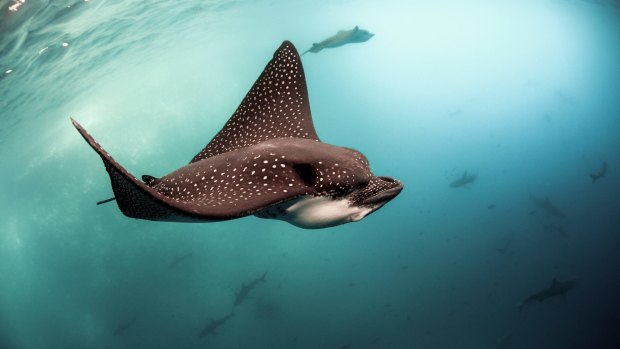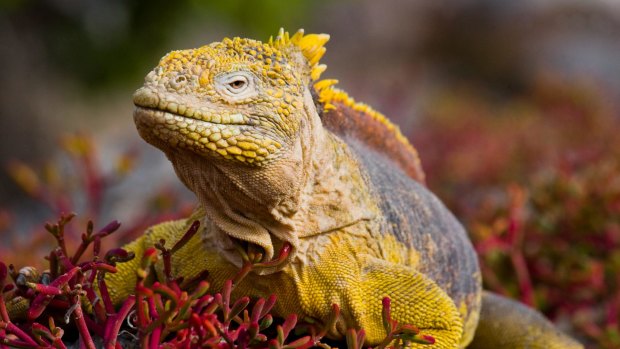This was published 5 years ago
Snorkelling in the Galapagos Island: A magical underwater world revealed

Spotted eagle ray.Credit: SHUTTERSTOCK
We've swum into the frame of a David Attenborough documentary. Attenborough himself must surely be floating somewhere nearby, observing us as we're subsumed by this underwater universe: marine iguanas foraging for algae on a bed of volcanic rocks; sea lions corkscrewing playfully through the water; turtles paddling by comically, their necks straining and eyes bulging towards some unseen objective.
A tern dives from the rookery on the cliffs above into the space between us, piercing the water with its razored beak, skewering a fish on its tip and bulleting airwards in triumph. We've tracked its split-second movement through snorkelling masks and our heads burst through the surface in time with the bird's so we're able to catch its startled expression at it emerges into this encirclement of humans.
Attenborough's mellifluous backing track plays inside our heads: "The tern regards the human interlopers for a brief and confused moment," he might say, "swallows his hapless prey, then takes off for the cliff arising like a spire beside this most nourishing of oceans."

Galapagos land iguana.Credit: SHUTTERSTOCK
My daughter is radiant beneath her mask. She wears an expression of joy so pure it jolts me. This is the Attenborough Effect: a state of unbridled awe triggered by her immersion in a world first conjured on television by the beloved conservationist when she was just a child. It's the exhilaration of being physically surrounded – so close, you could reach out and touch them! – by the creatures that once swam across our TV screen.
Oh, the hours she spent reverently agape in front of Attenborough's documentaries; the experiments the beloved scion inspired in her: aged eight, she and her best friend buried a dead possum in our garden; two weeks later they exhumed its decomposed corpse and boiled the remains (unbeknown to me) in my soup pot. The bones – bleached by time, heat and water – were laid out in a perfect skeletal representation of this once-three-dimensional creature.
My daughter had fallen in love – not just with the world illumed by Attenborough, but with the man himself. (She is now 19 and his poster is still pinned to her bedroom wall, her shelf lined with his books, his face embroidered onto her denim jacket). Such adoration of Attenborough and his decades-long quest to unearth the mysteries of the natural world is widespread – particularly among the young. Indeed, when the much-anticipated documentary series Planet Earth II debuted in 2016, it attracted more young viewers than the concurrently broadcast The X Factor. Attenborough himself understands just how important such attention is, for conservation literacy among young people is crucial to protecting the planet's future.
"It is our environmental legacy that the younger generation of today will inherit," he told London's The Telegraph. "We need them to become the environmental champions of the future."
Environmental awareness and desire for change is increasing, as the recent climate change strike by Australian school students indicates. And operators such as Lindblad Expeditions are harnessing young travellers' enthusiasm with family-style, conservation-focused itineraries and such initiatives as the National Geographic Global Explorers program, which aims to nurture global stewardship.
On the Galapagos' youngest and most westerly island, Fernandina, one such steward – my daughter – is tracing her hero's steps. We navigate the roped lava sediment flowing from La Cumbre volcano all the way down to the shoreline, skirt glowing bouquets of lava cacti, and stop to contemplate the bleached whalebones set out in perfect formation on petrified rock: a unification of dead matter harvested from ocean and earth – and a reminder of that possum skeleton now stored in a Ziploc bag back home.
It was here on Fernandina that the now-famous sequence in the first episode of Planet Earth II was filmed: an apparently infinite swarm of racer snakes chasing a just-hatched marine iguana as it flies across the beach and desperately grips the jagged volcanic ramparts. (Spoiler alert: the wily newborn miraculously escapes.)
We see no snakes today, just vast colonies of marine iguanas lazing on volcanic buttes with nary a care in the world. They slouch upon each other's leathery bodies, shoot jets of saltwater from their nostrils and absorb the sun's rays as protection against their frigid feeding grounds. Sawtooth frills run the length of their spines, differentiating the sooty reptilian mass from the tarry flows on which they lounge. "If you come here at noon," says Lindblad naturalist Enrique Silva, "this rock will be piping hot." A pink aperture disrupts the monochrome tableau as an iguana's prehistoric mouth, blunted by evolution, expands into a gargantuan moist yawn.
Of all the creatures observed in the Galapagos by Attenborough – and catalogued much earlier by Charles Darwin (whose theory of evolution was inspired during his voyage to the Galapagos in 1835) – this bizarre specimen, the world's only sea-going lizard, surely hints most meritoriously at evolution. Its ancestor is thought to have floated to this isolated archipelago – about 600 nautical miles off the coast of Ecuador – on a mat of vegetation. Diverging from the golden-hued Galapagos land iguana, the aquatic species evolved to withstand oceanic conditions: they can hold their breath for extended periods, are adept at swimming, use their blunted mouths to scrape algae off the volcanic seabed – and, once back on land, effusively expel the saltwater ingested as they swallow their marine meals.
Setting sail from our mooring at Fernandina, we're presented with the startling geology of this once-submerged archipelago in the volcanoes that have risen from the depths like fuming emeralds and strung themselves out on Isabella Island. They're wreathed in fog generated by the cold, deep equatorial counter-current that washes up against these westerly shores. Somewhere deep below us, the tectonic plates that created these formations are colliding still.
"The open book of geology is out there," says Lindblad Expeditions' leader and geologist Paula Tagle Saad as we gaze at jagged bulwarks harbouring such curiosities as flightless cormorants and blue-footed boobies.
"In 20 million years, the whole archipelago will sink beneath the South American plate. But that's in 20 million years, so you have time to come back with your children and your grandchildren."
Next morning my child is right beside me as I plunge into the bracing waters of Espumilla-Bucanero. We discover beneath the surface a soup of microscopic jellyfish, polyps afloat in the sea. Other subaquatic inhabitants come slowly into view: a heavily pregnant sea lion torpedoing past us, dragging our heads in her direction as though by her wake. Slow-motion turtles sashaying like synchronised dancers. A diminutive penguin – evolved with insular dwarfism so as to remain viable – jumping into the ocean right beside us.
Something flashes now in the corner of my eye: a golden ray hovering in the jellied gloom. I squeeze my daughter's hand and together we swim towards it. One ray becomes two and then five and fifteen; I stop counting at 25. They rise towards us like a gilded swarm. Attenborough's voice hums in our heads again, narrating the rays' story as we follow them into deeper water. But as swiftly as they've arisen, they dissolve again into the blue. No one has seen them except for my daughter and me. They might as well not exist, if not for each other's witness.
FIVE MORE EDUCATIONAL EXPERIENCES IN THE GALAPAGOS
VISIT A LOCAL SCHOOL
Younger travellers can connect with other kids during a visit to Tomás de Berlanga School on Santa Cruz Island. Many of the students here receive scholarships from Lindblad Expeditions-National Geographic and other donors; guests are encouraged to bring along a favourite book for its library.
TAKE A GLASS-BOTTOMED BOAT RIDE
Enjoy the underwater world – and accompanying commentary from a naturalist – from the comfort of a glass-bottomed boat: bright fish, frolicking sea lions, spiny sea urchins, speckled sea stars and mating jellyfish.
SEE LONESOME GEORGE
A species went extinct when Lonesome George – the last surviving Pinta Island tortoise – died aged about 120 in 2012. His preserved body is on display at the Fausto Llerena Giant Tortoise Breeding Centre on Santa Cruz Island, serving as a reminder of the importance of conservation.
READ
Darwin's Origin of Species might be heavy-going, but there's something relevant for younger readers, too: Lindblad Expedition-National Geographic leader Paula Tagle Saad – a geologist originally drawn to the Galapagos for its volcanoes – has penned Galapagos Bedtime Stories to educate children about conservation in the region.
TAKE A VIRTUAL TOUR
Visit the Galapagos wherever in the world you are with Google Street View's close-up study of the archipelago's land, coast and sea. See google.com.au/maps/about/behind-the-scenes/streetview/treks/galapagos-islands
TRIP NOTES
Catherine Marshall and her daughter were guests of Lindblad Expeditions.
MORE
VISIT
Lindblad Expeditions' 10-day cruise around the Galapagos on the National Geographic Endeavour II starts at about $9770 per person twin share, and includes return charter flights between Guayaquil and the Galapagos. See au.expeditions.com or call 1300 361 012
FLY
Qantas and its codeshare partner LATAM offer daily flights to Santiago from Sydney and Melbourne. LATAM offers onward connections to Guayaquil. See qantas.com and latam.com/en_au
Sign up for the Traveller Deals newsletter
Get exclusive travel deals delivered straight to your inbox. Sign up now.